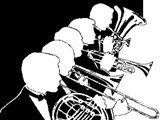
How to Use this Guide
The majority of the material in this project is in the form of annotated excerpts from original brass quintet compositions. Each excerpt is included as it appears in the complete horn part, so that players can become accustomed to how the music will appear in an actual performance. In addition, editorial comments addressing tempos, composers’ indications, and other performance considerations are included in brackets []. One possible use for this portion of the text would be as an etude book covering a range of traditional and modern techniques on the horn. As a companion to this collection I also recorded excerpts from many of these compositions to be used as a guide when studying this repertoire
Numerous sources have been consulted in choosing the excerpts included. One of the most important of these is the large body of recordings available commercially and through university libraries. In preparing a list of standard brass quintet compositions, one of the most important considerations was if the work had been recorded. Included in this guide is an annotated Discography of these works intended for use in conjunction with the musical examples included in this collection. The titles of these compositions and other related information appear as they are listed in WorldCat, an online database of university library holdings around the world.
Pedagogical texts and bibliographies of brass quintet music also provided important information for the selection of a standard brass quintet repertoire. When only one recording of a given composition existed, these texts often became the deciding factor on whether to include the work in this collection. One of the most substantial of these texts is Douglas Hill’s Collected Thoughts on Teaching and Learning, Creativity, and Horn Performance. A holistic text on horn performance and teaching, Collected Thoughts includes a list of brass quintet repertoire, with special emphasis on those pieces Hill considers basic literature for the ensemble. 1 Also important is Hill’s earlier text Extended Techniques for the Horn: A Practical Handbook for Students, Performers, and Composers. Hill includes a list of works containing advanced techniques for the horn, a significant number of them written for the brass quintet. 2 Other important pedagogical sources include Verne Reynolds’ The Horn Handbook and Barton Cummings’ Teaching Technique on Brass Instruments. Both of these works contain lists of important brass quintet repertoire. 3 Donald K. Day’s “A Comprehensive Bibliography of Music for Brass Quintet,” which originally appeared in The Instrumentalist publication, also provided other compositions for consideration.4
Marta Jean Hofacre’s dissertation on the use of the tenor trombone in twentieth-century brass quintet music provided even more specific information on important brass quintet compositions. As part of her study, Hofacre sent surveys to fifty-six well known trombone performers and teachers across the United States. These surveys asked the participants to rank what were in their opinions the most important brass quintet works “written by American composers from 1938 to 1980,” and those “written by foreign composers from 1900-1980.” Although the participants in these surveys are not horn teachers or performers, their experience with brass quintet repertoire was significant enough to respect many of their selections, especially those unanimously selected as the top five to ten brass quintet compositions in each survey. 5
After considering these various sources, fifty-five works were selected for inclusion in this collection. Although this list of standard works is by no means comprehensive, it is representative of the large body of original brass quintet compositions, and provides numerous examples for study. Whenever possible, full scores, individual parts, and recordings were consulted to determine which portions of the works would be excerpted. The Excerpt Classification page presents an annotated list of these excerpts, with abbreviations denoting their relevance and reason for being excerpted. Individual lists are also provided for five major excerpt categories; solo, high register, low register, technical, and extended techniques. These lists can be used to provide a more directed study of brass quintet literature, allowing players to focus on those compositions and passages that emphasize a particular range or performing technique. Consult the Range Requirements page for complete range requirements for each work, which can be used to help both players and teachers make informed decisions when choosing repertoire for their ensembles.
1 Douglas Hill, Collected Thoughts on Teaching and Learning, Creativity, and Horn Performance (Miami, FL: Warner Brothers Publications, 2001), 146.
2 Douglas Hill, Extended Techniques for the Horn: A Practical Handbook for Students, Performers, and Composers (Miami, FL: Warner Brothers Publications, 1983, 1996).
3 Verne Reynolds, The Horn Handbook (Portland, OR: Amadeus Press, 1997), 194. and Barton Cummings, Teaching Technique on Brass Instruments (Troy, MI: Encore Music Publishers, 1997), 126-128.
4 Donald K. Day, “A Comprehensive Bibliography of Music for Brass Quintet,” in The Brass Anthology (Evanston, IL: The Instrumentalist Co., 1980), 649.
5 Marta Jean Hofacre, “Use of Tenor Trombone in Twentieth-century Brass Quintet Music: a Brief Historical Overview with a Comprehensive Listing of Original Published Twentieth-century Quintets and a Discussion of Tenor Trombone Excerpts from Selected Compositions” (D.M.A. diss., University of Oklahoma, 1986), 215-220.